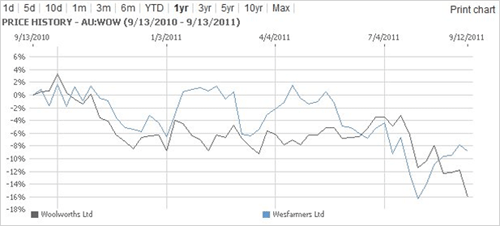In another exciting round of publicly traded companies dueling it out – which of these two will come out on top as being worthy of your investment dollars?
The Skinny on Wesfarmers (WES)
Wesfarmers Limited is a diversified group with operations in hardware, liquor, petrol, discount operations, office supplies, coal mining, chemicals, insurance, and more.
Dividend yield currently sits just under 5% with 90% of earnings being paid out. Although the average sales growth over the past 5 years sits at 44%, this has dropped hard to just 5.9% recently. That being said, earnings growth is still high at 22.7% year over year.
Net profit margins – or the amount of every revenue dollar they retain as profit has historically been below the industry average of 4.6% at about 3.5%. However, they have financial strength and have been paying down on long-term debt – almost cutting the 8.26 billion dollar debt figure in half.
What about future forecasts? Revenue is expected to grow 29% in 2012 and 11.4% in 2013. Earnings are largely expected to grow by almost 44% over the next 5 years. This company is flexing its financial muscles and analysts agree that it has strong prospects.
The Skinny on Woolworths (WOW)
Woolworths is a retailer with primary activities in food and alcohol, with smaller components in electronics, petrol, and hotels.
Woolworths offers a similar dividend to Wesfarmers at 4.81% with a slightly lower payout ratio of 70%. Sales growth is the backbone of a company expanding – and Woolworths has typically underperformed the industry group. Unlike Wesfarmers, earnings growth is also low with only 6.4% growth year over year. The 5 year average is better – but still say below Wesfarmers.
Net profit margins are similar to Wesfarmers, meaning they can keep about the same percent of revenue as profit. Debt, on the other hand, is worse. Their long-term debt has jumped 50% since 2008, and their current liabilities has also risen by 40%. The debt-to-equity ratio is over 3 times higher than Wesfarmers.
And the future forecast? Revenue growth is expected to be single digits only for 2012 and 2013. Earnings growth for the next 5 years is expected to be 14.83% over the next 5 years – which is in line with the industry group.
Wesfarmers VS Woolworths: The Winner?
This one is easy, I give it to Wesfarmers. They have paid down on debt, achieved higher growth, and have better forecasts for the future. Although their price-to-earnings ratio is a few points higher, they are still comparable. Due to the financial strength of Wesfarmers, their dividend should be more reliable and the amount of earnings they need to payout should drop.
What about the price performance?

While Wesfarmers has dropped 8% over the past year, Woolworths has corrected twice that much, or 16%. While we still lie in choppy waters for the short-term, the long-term picture is much brighter for Wesfarmers. My recommendation: put your hard-earned dollars into WES.